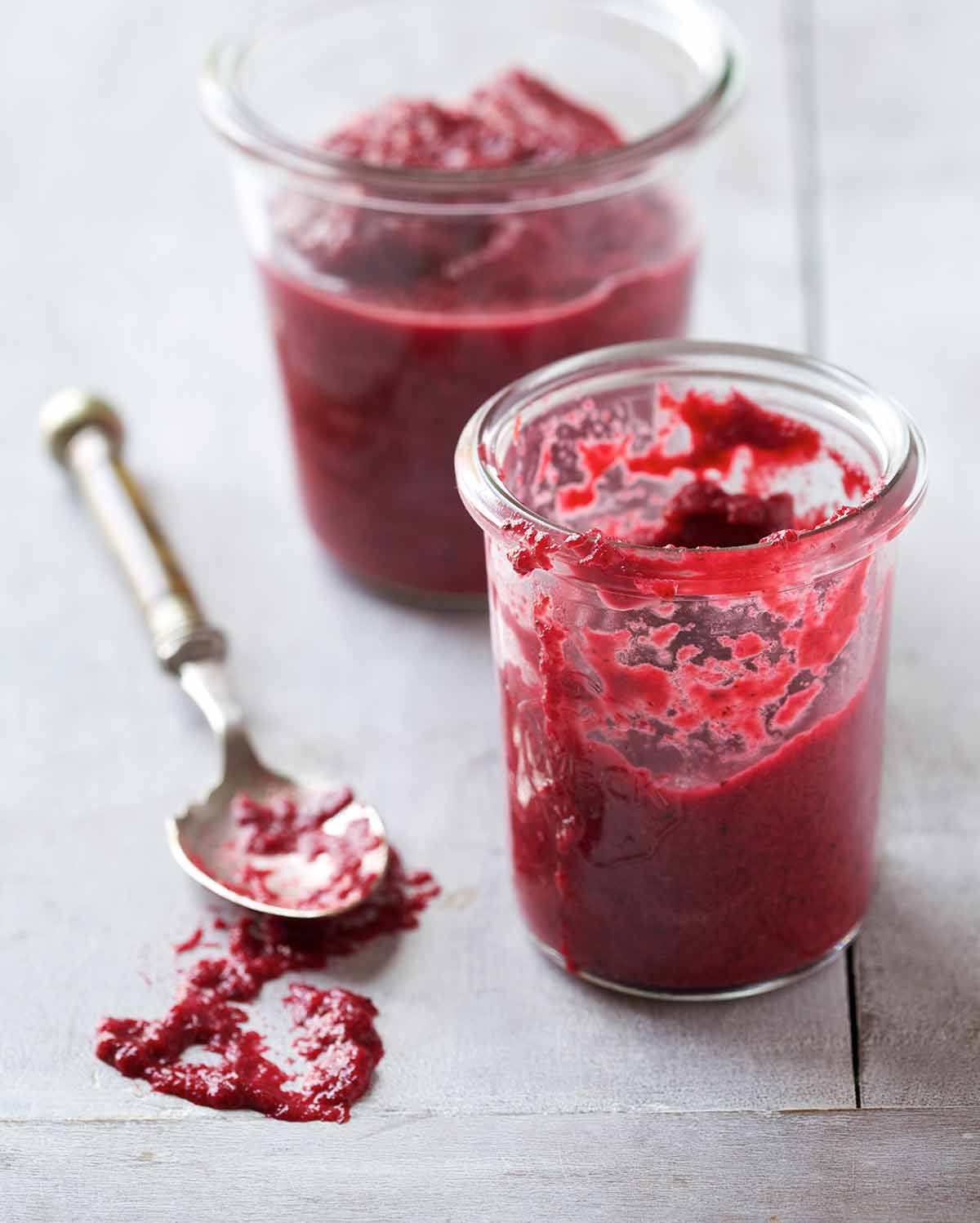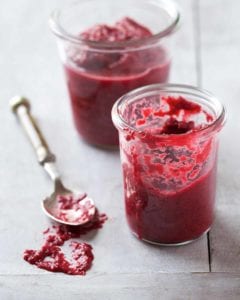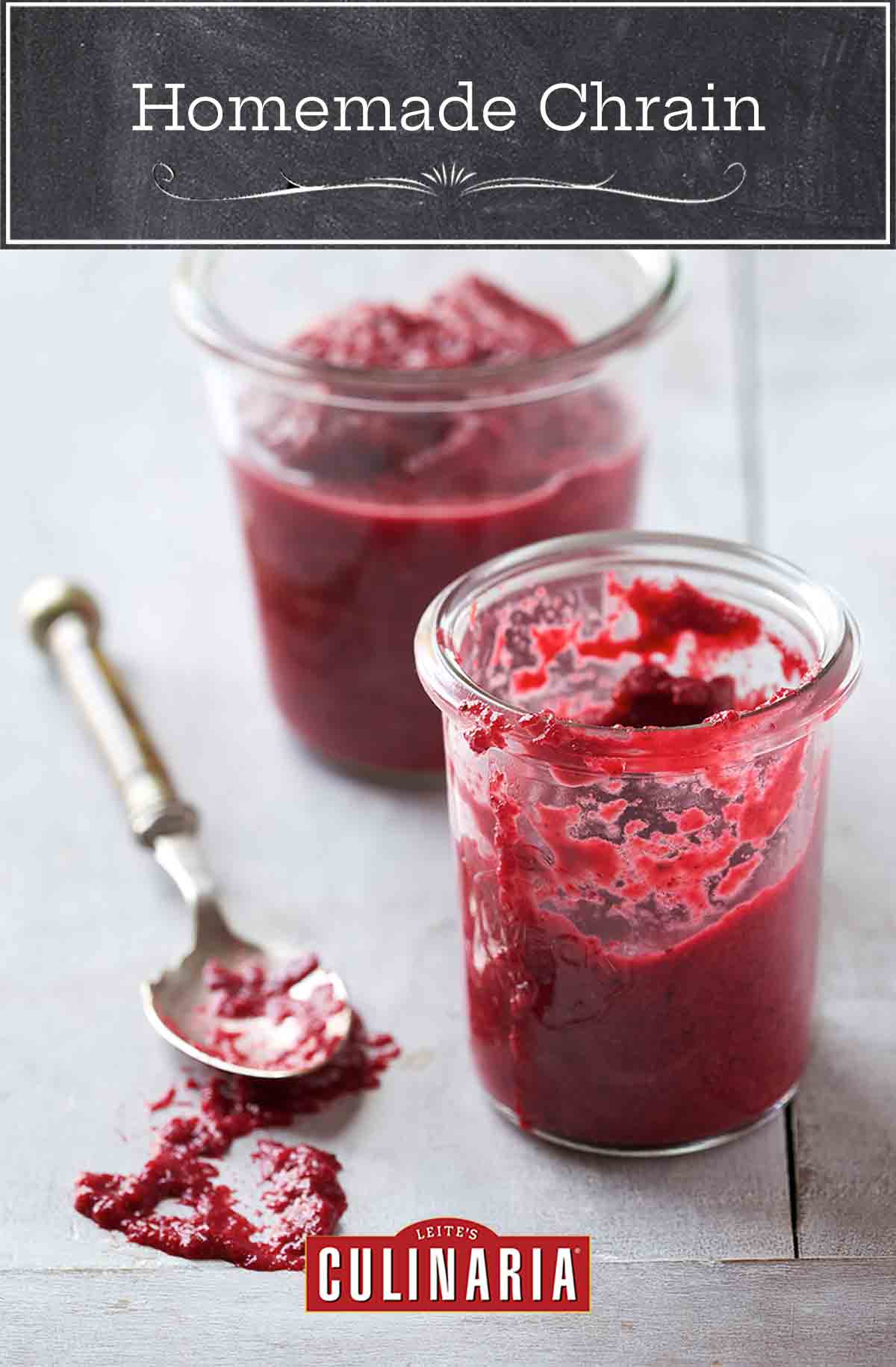
I make chrain for Pesach. It’s easy with a food processor, and the results are glorious. I’ll never buy it again. Double or triple the quantities, if you wish.–Ruth Joseph and Simon Round
Chrain FAQs
What’s chrain, you ask? It’s a heck of a memorable condiment traditionally found on the holiday table come Passover and, in eastern Europe, Easter. Its bracing robustness is most terrific alongside rich dishes such as deviled eggs, gefilte fish, and roasted hen, although it also works admirably as a dip with crudités. Depending on the precise proportion of ingredients that the cook chooses, the condiment’s characteristics are either that of a magenta beet relish spiked with a touch of horseradish or a clear-the-sinuses horseradish paste with a tinge of pink—suit yourself, tweaking and tasting as you make it. Lurking in some of your minds is no doubt the question, Why make it when I can buy it? In response, we have only to quote LC recipe tester and chrain aficionado Sema Stein: “Although a veteran chrain user, this was the first time I have made it myself. The result was delicious with a serious bite to it. I must say, it is the best chrain I have ever had.” Tasting, it seems, is believing.
While this recipe doesn’t result in an enormous amount of chrain, you may have some leftovers. Your best bet is to put it in an airtight container in the fridge – it should last about a week. And yes, you can also freeze it, but be aware it may lose some of its pungency in the process. If you elect to use the freezer option, we recommend spooning your chrain into an ice cube tray, then popping the frozen chrain-sicles into an airtight Ziploc-type bag and storing it in your freezer until you’re ready to use it again.

Homemade Chrain
Ingredients
- 3 medium beets, unpeeled but scrubbed
- One (1- by 3-inch) piece fresh horseradish, peeled and roughly chopped, or more to taste (may substitute prepared horseradish to taste)
- 2 tablespoons cider vinegar (or substitute balsamic vinegar)
- 1 tablespoon olive oil
- 1 1/2 to 2 teaspoons salt
- 1 to 1 1/2 teaspoons granulated sugar
- 1 garlic clove, peeled (optional)
Instructions
- Place the whole, unpeeled beets in a large saucepan and add enough water to cover. Bring to a boil and cook until tender, 30 to 45 minutes.
- Drain the beets and rinse them under cold running water until they’re cool enough to handle. Using your fingertips, slip off the skins. Then coarsely chop the beets. (You should have about 4 cups, give or take a little.)
- Place the chopped beets along with the remaining ingredients in a food processor and process until the desired consistency. (Consider adding the smaller amount of salt and sugar for starters, then toss in more if desired.) Taste and adjust the amount of horseradish accordingly. Cover and refrigerate the chrain for up to 1 week.

Nutrition
Nutrition information is automatically calculated, so should only be used as an approximation.
Recipe Testers’ Reviews
Though a veteran chrain user, this was the first time I’ve made it myself. The result was delicious, with a serious bite to it. I must say, it’s the best chrain I’ve ever had and I won’t be buying it again.
The end result was a beet paste with very small chips of visible white horseradish. I processed the mixture for what seemed like a long time, but wasn’t able to reduce the horseradish root to a paste. I stopped processing due to concern that the beet would become too mushy and not hold up against the gefilte fish that it was paired with. I used cider vinegar and I’d increase the sugar to 1 1/2 teaspoons and reduce the salt to 1 1/2 teaspoons. I didn’t use the garlic.
The color of this alone makes this a winner. The homemade chrain also clears out the sinuses very efficiently. And it’s delicious in small doses.
The flavor is good, but the consistency is very different than the beet-colored horseradish you get in a jar.
There was an issue with the recipe for me: it called for 3 medium-size beets and a 1-by-3-inch piece of horseradish. I think it had too much beet compared to the amount of horseradish for my taste, but the ratios I used created a very spicy result.
The amount of beet I added gave the chrain a more gelatinous consistency than the grainy horseradish consistency I’m used to. The other recipes I found showed a higher ratio of horseradish to beet. But the flavor was good. I used cider vinegar, which imparted the right flavor. No need for the sugar, though, unless spicy isn’t what you want.
This homemade chrain is an easy recipe which has multitude of applications. Starting as a humble dip, it could easily be a condiment or stirred into some soups or stews or added to hummus or just eaten by itself with some fresh pita or naan bread. I used about 2 tablespoons prepared horseradish as fresh was not available to me. Personally, I would add a little more horseradish and a splash of lemon next time I make this.
I’ve always purchased red horseradish to use alongside gefilte fish, but never considered making it until I saw this recipe. Armed with a very fresh and aromatic horseradish root that I purchased at the greenmarket, I headed to my kitchen, got the food processor out, and put the beets on to boil.
After reading some of the comments I opted to use a larger piece of horseradish, about 4 inches long. I ended up using about 2 teaspoons salt and 1 1/2 teaspoons sugar along with cider vinegar. I opted to omit the garlic.
The homemade chrain was delicious and intensely hot, though the beets added sweetness as well as turning the dish a magnificent color. I made it two days before Passover and stored it in a glass jar in the refrigerator, and there was no significant loss of intense flavor. (In fact, a week later my remaining chain is still hot and delicious.) This was a perfect addition to my Passover table and an excellent accompaniment to gefilte fish. It’s also a great accompaniment to matzoh, and we even enjoyed adding a bit of it to chicken salad.
The key is definitely a fresh, flavorful horseradish root—the one I purchased at the greenmarket was definitely a superior product to those available at my local supermarket. Also, when opening the food processor, be very careful as the aroma is truly overwhelming. Last, when I work with beets I always cut them on a stack of newsprint to avoid staining my cutting boards and I wear rubber gloves to avoid staining my hands.













Wayyyyy over here on the other side of the planet, in .au, my Polish-origin mother also makes this Easter specialty. Fresh horseradish root used to be hard to come by, so she has always used the jarred variety. Like Miss Fortier above, it is eaten traditionally on Easter Sunday bruch with the various divine Polish sausages and boiled eggs, and ham. Thank you for posting this recipe, I will share it with her and compare notes, then look forward to our Easter feast!
Can’t wait to hear, Eva. Will you make some for her to compare?
My mother makes two kinds of chrain: one with cooked beetroots and one with raw. You need to very finely grate the horseradish, and the beetroots as well, but separately. Mix them by pulses in the magimix. And season them at the end with sugar and salt dissolved in vinegar. No need for oil, especially not olive oil. Divide into small amounts in glass jars to keep the sharpness.
Thank you, your mother’s chrain sounds fabulous, and we so appreciate you sharing her tried-and-true techniques. I’m certain I’m not the only one who appreciates them and will be incorporating them into my next batch….
This is a popular side dish in Eastern Europe. Horseradish root (“hren”) is commonly added to jars when preserving vegetables for winter.
I love this, Anna. What other vegetables are commonly used?
Basically horseradish is used as batonnets in all kinds of pickles (dill, sauerkraut, insanely good sauerkraut-filled peppers, green tomatoes, cauliflower, carrots etc.) My grandmother preserved whole green peppers only with horseradish and tap water and never failed, all were good and firm when taken out to be stuffed. She put a couple of batonnets inside every pepper and then tucked them one inside the other, making sort of a “pepper tower”. Needless to say, we are not talking 16 ounces here, but 10 to 20 liters (3 to 6 gallons) or even wooden barrels for sauerkraut.